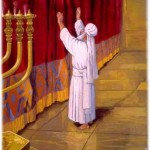Will the Temple be rebuilt – and if so, when?
 Addir Hu, Addir Hu, yivneh veto bekarov – “Mighty is He, mighty is He, soon may He rebuild His House: speedily, O speedily in our days, Lord, rebuild it, re-build Your House soon!”
Addir Hu, Addir Hu, yivneh veto bekarov – “Mighty is He, mighty is He, soon may He rebuild His House: speedily, O speedily in our days, Lord, rebuild it, re-build Your House soon!”
With these words one of the most popular Seder night songs commences, and verse by verse we implore the Almighty to rebuild His Temple.
But will the Temple be rebuilt – and if so, when?
These are the questions which this article discusses.
Jewish thinking has never been content to regard the Temple as merely a part of ancient history.
For almost two millennia, the yearning for the Sanctuary to be rebuilt has moved the Jewish heart and figured in the Jewish liturgy.
Since the re-unification of Jerusalem in 1967, however, the subject has taken on new intense relevance, and voices have been raised with the suggestion that rebuilding should now move out of the realm of dreams and become a matter of practical planning.
It seems likely, however, that action will be impossible and impracticable without Messianic intervention.
The first difficulty in the way of rebuilding the Temple is presented by the weighty body of opinion which holds that observant Jews may not set foot on the Temple Mount.
According to the Mishnah, there are various degrees of sanctity. Thus the land of Israel is the holiest land on earth, Within Israel the holiest city is Jerusalem. Within Jerusalem itself the holiest spot is the site of the Temple. And within the Temple the holiest area is the Holy of Holies.
The holier the place, the higher the degree of ritual purity required of those who seek access to it. Without such ritual purity, the person concerned would be guilty of a grave sin.
It is easily understandable that these regulations had application while the Temple was still standing. But what is the situation since the destruction of the Temple?
The normative view is that of Maimonides whose Code holds that the Temple site retains its sanctity. Says Maimonides: “This is because the holiness of the Temple and of Jerusalem derives from the shechinah (the Divine presence) which is forever there”.
Although this view is rejected by some, and some medieval writers do record that in their days it was not unknown for Jews to enter the Temple site, Maimonides’ ruling is generally accepted by the authorities on Jewish law.
Thus without undergoing ritual purification an observant Jew may not enter the site of the Temple, not to speak of beginning to rebuild it.
Now there is one form of purification – immersion in a mikveh, or ritual bath – which is possible today. In theory this would enable entry to the Temple surrounds – though not to the inner area, since the latter would require a complicated procedure involving the ashes of a red heifer, as commanded by the Bible, a procedure which has not been available since ancient times.
In 1967, Rabbi Shlomo Goren, who was then chief chaplain to the Israeli forces, ascended the Temple Mount with a small group of supporters and held a service at the outer extremity of what he regarded as the Temple site. This act aroused fierce controversy as most rabbinic authorities refuse to permit entry even to this part of the areas.
They fear that people might trespass further in error, and in any case all our careful research has not enabled us to identify the precise location of the various features of the Temple, and thus no-one can be certain of not trespassing onto the inner areas. Hence the whole site is regarded as out of bounds.
One incidental question now arises: may the observant Jew even perform guard duty at the Temple site?
This aspect comes under a category known in Jewish law as pikku’ach nefesh, which is an emergency provision permitting the law (with the exception of the prohibition of idolatry, murder and adultery) to be set aside when there is danger of life or health.
This principle applies most characteristically in cases of serious illness, where the needs of the patient over-ride the requirements of religious law. The Sabbath, for instance, may be desecrated if the patient’s condition makes this necessary; the rule is, “Desecrate one Sabbath for him so that he may live to observe many future Sabbaths.”
Defence of one’s country or its security would come within the principle of pikku’ach nefesh, and on this basis one could perform guard duty on the Temple mount provided his infraction of the law were kept to a minimum.
He may however not carry into the Temple area any items of equipment not essential for security purposes, and he must act whilst there with the greatest of reverence.



